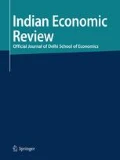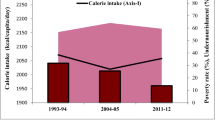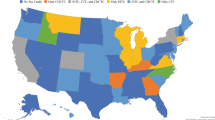Abstract
Empirical studies on food expenditure are largely based on cross-section data and for a few studies based on longitudinal (or panel) data the focus has been on the conditional mean. While the former, by construction, cannot model the dependencies between observations across time, the latter cannot look at the relationship between food expenditure and covariates (such as income, education, etc.) at lower (or upper) quantiles, which are of interest to policymakers. This paper analyzes expenditures on total food (TF), food at home (FAH), and food away from home (FAFH) using mean regression and quantile regression models for longitudinal data to examine the impact of economic recession and various demographic, socioeconomic, and geographic factors. The data are taken from the Panel Study of Income Dynamics (PSID) and comprise of 2174 families in the United States (US) observed between 2001 and 2015. Results indicate that age and education of the head, family income, female-headed family, marital status, and economic recession are important determinants for all three types of food expenditure. Spouse education, family size, and some regional indicators are important for expenditures on TF and FAH, but not for FAFH. Quantile analysis reveals considerable heterogeneity in the covariate effects for all types of food expenditure, which cannot be captured by models focused on conditional mean. The study ends by showing that modeling conditional dependence between observations across time for the same family unit is crucial to reducing/avoiding heterogeneity bias and better model fitting.

Similar content being viewed by others
Availability of data and material
The data used in publicly available from the Panel Study of Income Dynamics, University of Michigan, Ann Arbor.
Code availability
The codes are available on request.
Notes
The American Recovery and Reinvestment Act (ARRA) of 2009 renamed the FSP to SNAP and increased benefits by an average of $80 per household. However, a common variable to capture SNAP participation pre- and post-ARRA is not available in PSID.
Within the SNAP literature, the central debate is whether households respond similarly to an increase in cash income and in-kind transfer (food coupons). While some researchers, such as Hoynes and Schanzenbach (2009), have found that the response is similar; others such as Beatty and Tuttle (2014) have found that households increase in food expenditure is more when given an in-kind transfer (food stamps) as compared to cash income.
The terms fixed-effects and random-effects have been used to mean different things in the literature and there is no agreed-upon definition. In this paper, fixed-effects refers to regression coefficients that do not differ across i (or individuals) and random-effects mean regression coefficients that differ across i (see Greenberg 2012, Ch. 10). Andrew Gelman lists five different definitions of fixed-effects and random-effects at https://statmodeling.stat.columbia.edu/2005/01/25/why_i_dont_use/. But again, there are other popular definitions such as in Classical econometrics where fixed-effects means that the unobserved individual-specific heterogeneity is correlated with the regressors, while random-effects imply zero correlation (or more strongly statistical independence) between individual-specific heterogeneity and the regressors (see Cameron and Trivedi 2005; Wooldridge 2010; Hsiao 2014; Greene 2017).
References
Aguiar, M., & Hurst, E. (2005). Consumption versus expenditure. Journal of Political Economy, 113(5), 919–948.
Antelo, M., Magdalena, P., & Reboredo, J. C. (2017). Economic crisis and the unemployment effect on household food expenditure: The case of Spain. Food Policy, 69, 11–24.
Beatty, T. K. M., & Tuttle, C. J. (2014). Expenditure response to increases in in-kind transfers: Evidence from the supplemental nutrition assistance program. American Journal of Agricultural Economics, 97(2), 390–404.
Binkley, J. K. (2008). Calorie and gram differences between meals at fast food and table service restaurants. Applied Economic Perspectives and Policy, 30(4), 750–763.
Bresson, G., Lacroix, G., & Rahman, M. A. (2020). Bayesian panel quantile regression for binary outcomes with correlated random effects: An application on crime recidivism in Canada. Empirical Economics (forthcoming),. https://doi.org/10.1007/s00181-020-01893-5.
Burney, S. (2018). In-kind benefits and household behavior: The impact of SNAP on food-away-from-home consumption. Food Policy, 75, 134–146.
Byrne, P. J., Capps, O., & Saha, A. (1996). Analysis of food-away-from-home expenditure patterns for U.S. households, 1982–89. American Journal of Agricultural Economics, 78(3), 614–627.
Cai, Y., Alviola, P. A., Nayga, R. M., & Wu, X. (2008). The effect of food-away-from-home and food-at-home expenditures on obesity rates: A state level analysis. Journal of Agricultural and Applied Economics, 40(2), 507–521.
Cameron, A. C., & Trivedi, P. K. (2005). Microeconometrics: methods and applications. Cambridge: Cambridge University Press.
Casella, G., & George, E. I. (1992). Explaining the Gibbs sampler. The American Statistician, 46(3), 167–174.
Chib, S., & Carlin, B. P. (1999). On MCMC sampling in hierarchical longitudinal models. Statistics and Computing, 9(1), 17–26.
Darian, J. C., & Klein, S. W. (1989). Food expenditure patterns of working-wife families: Meals prepared away from home versus convenience foods. Journal of Consumer Policy, 12(2), 139–164.
Davis, G. C. (2014). Food at home production and consumption: Implications for nutrition quality and policy. Review of Economics of the Household, 12, 565–588.
Delattre, M., Lavielle, M., & Poursat, M. A. (2014). A note on BIC in mixed-effects models. Electronic Journal of Statistics, 8(1), 456–475.
Devroye, L. (2014). Random variate generation for the generalized inverse Gaussian distribution. Statistics and Computing, 24(2), 239–246.
Drichoutis, A. C., Nayga, R. M., & Lazaridis, P. (2012). Food away from home expenditures and obesity among older Europeans: Are there gender differences? Empirical Economics, 42(3), 1051–1078.
Friedline, T., Masa, R. D., & Chowa, G. A. (2015). Transforming wealth: Using the inverse hyperbolic sine (ihs) and splines to predict youth’s math achievement. Social Science Research, 49, 264–287.
Gelber, A. M., & Mitchell, J. W. (2012). Taxes and time allocation: Evidence from single women and men. The Review of Economic Studies, 79(3), 863–897.
Geman, S., & Geman, D. (1984). Stochastic relaxation, Gibbs distributions, and the Bayesian restoration of images. IEEE Transactions on Pattern Analysis and Machine Intelligence, 6(6), 721–741.
Greenberg, E. (2012). Introduction to Bayesian econometrics. New York: Cambridge University Press.
Greene, W. H. (2017). Econometric analysis (8th ed.). New York: Prentice Hall.
Greven, S., & Kneib, T. (2010). On the behaviour of marginal and conditional AIC in linear mixed models. Biometrika, 97(4), 773–789.
Griffith, R., Connell, M. O., & Smith, K. (2013). Food expenditure and nutritional quality over the Great Recession. London: Tech. Rep., Institute for Fiscal Studies.
Handa, S. (1996). Expenditure behavior and children’s welfare: An analysis of female headed households in Jamaica. Journal of Development Economics, 50(1), 165–187.
Heckman, J. (1979). Sample selection bias as a specification error. Econometrica, 47(1), 153–161.
Hoynes, H. W., & Schanzenbach, D. W. (2009). Consumption responses to in-kind transfers: Evidence from the introduction of the food stamp program. American Economic Journal: Applied Economics, 1(4), 109–139.
Hsiao, C. (2014). Analysis of panel data (econometric society monograph). New York: Cambridge University Press.
Huang, J., Kim, Y., & Birkenmaier, J. (2016). Unemployment and household food hardship in the economic recession. Public Health Nutrition, 19(3), 511–519.
Kinsey, J. (1983). Working wives and the marginal propensity to consume food away from home. American Journal of Agricultural Economics, 65(1), 10–19.
Kohara, M., & Kamiya, Y. (2016). Maternal employment and food produced at home: Evidence from Japanese data. Review of Economics of the Household, 14, 417–442.
Kozumi, H., & Kobayashi, G. (2011). Gibbs sampling methods for Bayesian quantile regression. Journal of Statistical Computation and Simulation, 81(11), 1565–1578.
Lanfranco, B. A., Ames, G. C., & Huang, C. L. (2002). Food expenditure patterns of the Hispanic population in the United States. Agribusiness, 18(2), 197–211.
Lee, J. Y., & Brown, M. G. (1986). Food expenditures at home and away from home in the United States—a switching regression analysis. Review of Economics and Statistics, 68(1), 142–147.
Liu, M., Kasteridis, P., & Yen, S. T. (2013). Who are consuming food away from home and where? Results from the consumer expenditure surveys. European Review of Agricultural Economics, 40(1), 191–213.
Liu, H., Wahl, T. I., Seale, J. L., & Bai, J. (2015). Household composition, income, and food-away-from-home expenditure in urban China. Food Policy, 51, 97–103.
Luo, Y., Lian, H., & Tian, M. (2012). Bayesian quantile regression for longitudinal data models. Journal of Statistical Computation and Simulation, 82(11), 1635–1649.
Mancino, L., Todd, J., & Lin, B. H. (2009). Separating what we eat from where: Measuring the effect of food away from home on diet quality. Food Policy, 34(6), 557–562.
Mian, A., Rao, K., & Sufi, A. (2013). Household balance sheets, consumption, and the economic slump. The Quarterly Journal of Economics, 128(4), 1687–1726.
Nayga, R. M. (1996). Wife’s labor force participation and family expenditures for prepared food, food prepared at home, and food away from home. Agricultural and Resource Economics Review, 25(2), 179–186.
Ojha, M., Rahman, M.A. (2020). Do online courses provide an equal educational value compared to in-person classroom teaching? Evidence from US survey data using quantile regression, https://arxiv.org/pdf/2007.06994.pdf
Rahman, M. A. (2016). Bayesian quantile regression for ordinal models. Bayesian Analysis, 11(1), 1–24. https://doi.org/10.1214/15-BA939.
Rahman, M. A., & Karnawat, S. (2019). Flexible Bayesian quantile regression in ordinal models. Advances in Econometrics, 40B, 211–251.
Rahman, M. A., & Vossmeyer, A. (2019). Estimation and applications of quantile regression for binary longitudinal data. Advances in Econometrics, 40B, 157–191.
Redman, B. J. (1980). The impact of women’s time allocation on expenditure for meals away from home and prepared foods. American Journal of Agricultural Economics, 62(2), 234–237.
Stewart, H., & Yen, S. T. (2004). Changing households characteristics and the away-from-home food market: A censored equation system approach. Food Policy, 29, 643–658.
Stewart, H., Blisard, N., Jolliffe, D., & Bhuyan, S. (2005). The demand for food away from home: Do other preferences compete with our desire to eat healthfully? Journal of Agricultural and Resource Economics, 30(3), 520–536.
Wilde, P. E., Troy, L. M., & Rogers, B. L. (2009). Food stamps and food spending: An Engel function approach. American Journal of Agricultural Economics, 91(2), 416–430.
Wooldridge, J. M. (2010). Econometric Analysis of Cross Section and Panel Data (2nd ed.). Cambridge: MIT Press.
Yen, S. T. (1993). Working wives and food away from home: The Box-Cox double hurdle model. American Journal of Agricultural Economics, 75(4), 884–895.
Yu, K., & Moyeed, R. A. (2001). Bayesian quantile regression. Statistics and Probability Letters, 54(4), 437–447.
Zheng, Y., Dong, D., Burney, S., Kaiser, H.M. (2019). Eat at home or away from home? The role of grocery and restaurant food sales taxes. Journal of Agricultural and Resource Economics pp 98–116
Ziol-Guest, K. M., DeLeire, T., & Kalil, A. (2006). The allocation of food expenditure in married-and single-parent families. The Journal of Consumer Affairs, 40(2), 347–371.
Funding
Not Applicable.
Author information
Authors and Affiliations
Corresponding author
Ethics declarations
Conflict of Interest
On behalf of all authors, the corresponding author states that there is no conflict of interest.
Additional information
Publisher's Note
Springer Nature remains neutral with regard to jurisdictional claims in published maps and institutional affiliations.
Rights and permissions
About this article
Cite this article
Gupta, A., Mirghasemi, S. & Rahman, M.A. Heterogeneity in food expenditure among US families: evidence from longitudinal quantile regression. Ind. Econ. Rev. 56, 25–48 (2021). https://doi.org/10.1007/s41775-020-00101-6
Published:
Issue Date:
DOI: https://doi.org/10.1007/s41775-020-00101-6




